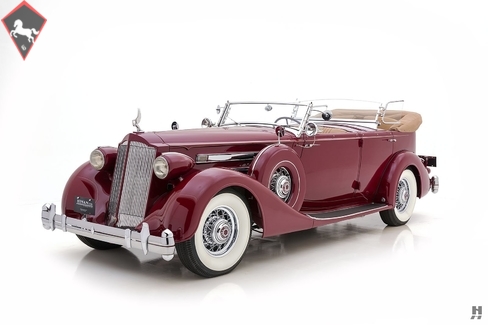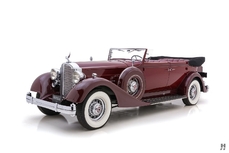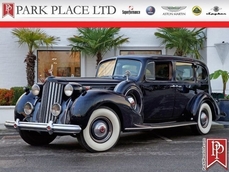Packard Twelve Dual Cowl Sport Phaeton 1936
General description :
While the Fourteenth Series of 1936 changed little from the 1935 Twelfth Series, the latest Packard served as a bridge between two significant eras in the company’s illustrious history. The twelve-cylinder models remained Packard’s top offering, with the Super Eight, Eight, and Junior series positioned below. Packard design had reached a turning point, which now firmly embraced the modern streamline era with its full-figured proportions, raked radiator shell, and aerodynamic detailing. Mechanically, it was a mix of modern and traditional, with the solid front axle suspension holding on for one more year, paired with powerful vacuum-assisted hydraulic brakes, synchronized gearbox, and finely tuned ride and handling. The flagship Twelve featured a 473 cubic-inch L-head V12, making 175 horsepower, matching the output of Cadillac’s complex OHV V16. By the second half of the decade, demand for lavish custom coachwork was waning, and customer tastes tended to favor more conservative and practical designs. Catalog custom designs by Deitrich, Le Baron, and Brunn continued to be offered, but they were produced in minuscule numbers compared to the standard Packard body-shop offerings.
This 1936 Packard 1407 Twelve is a stunning example of the 14th Series, equipped from new with beautifully proportioned and elegant Dietrich-designed Phaeton coachwork. It is offered with an older but finely preserved concours-quality restoration, finished in bold and striking colors, and equipped with a host of period accessories. It was updated with an accessory rear cowl and windscreen at the time of refurbishment, transforming it into a glamorous dual-cowl Phaeton. Since then, it has been maintained in excellent condition by a series of dedicated, knowledgeable enthusiasts. The gorgeous coachwork is resplendent in its vibrant maroon paintwork, which is smooth, glossy, and consistent with this being a former concours car. The body features numerous authentic accessories and options, including dual side-mount spares with matching hard-shell covers, Packard See Rite mirrors, Cormorant mascot, dual search lamps, chrome hood vents, and more. It has the low and purposeful stance that defines this generation of Packard, made particularly dramatic by 139-inch wheelbase, substantial vibration-dampening bumpers, wide whitewall tires, and chrome wire wheels.
Looking inside, we find tan leather upholstery finished to a high standard that displays a pleasing, lightly broken-in character. More fine details abound, including gorgeous woodgrain finishing on the dash and steering wheel, a marble shift knob, and fully restored instruments, controls, and switchgear. A factory Packard radio is integrated into the instrument panel. All four door panels are upholstered in matching tan leather, and the rears feature lovely, ornate wood trim. Rear passengers enjoy a spacious rear bench, folding footrest, and of course, the signature rear cowl and windscreen, which not only adds visual appeal but aids in the preservation of expensive hairstyles over a long journey.
For 1936, the Packard V12 displaced 473 cubic inches and produced an impressive 175 horsepower and a vast torque reserve for effortless forward progress. Beyond the numbers, though, the twelve’s unparalleled refinement put it at the top of the luxury car market in the late 30s. This car’s L-head V12 is correctly detailed in the signature Packard Green engine paint, with black porcelain manifolds and accessories. Some porcelain enamel has “baked- off” over time, but the engine remains tidy and appropriately well-finished. With some straightforward preparation, this car would be a superb choice for touring.
The Packard Twelve Dual-Cowl Phaeton is arguably the ultimate expression of prestige and luxury in the 1930s. This beautiful 1407 benefits from a high-quality restoration, which has mellowed just enough to make it the ideal choice for touring with groups like the Classic Car Club of America, Packard Club, and more. While ideally suited to on-road enjoyment, its beautifully maintained nature means it would still be a welcome sight for display in a variety of concours events around the country. Elegant, glamorous, and with enormous presence, this marvelous Packard is sure to please any enthusiast, from a seasoned veteran to a newcomer to the joys of Classic Era motoring.
Offers welcome and trades considered
https://hymanltd.com/vehicles/6778
1936 Packard Twelve Dual Cowl Sport Phaeton is listed sold on ClassicDigest in St. Louis by Mark Hyman for $239500.
Car Facts
Car type : Car Make : Packard Model : Twelve Model Version : Dual Cowl Sport Phaeton Engine size : 0.0 Model Year : 1936 Location : Missouri
Sold
Seller Information
Sold
People who viewed this Packard Twelve also viewed similar Packard listed at ClassicDigest
Other cars listed for sale by this dealer
About Packard
Packard: A Comprehensive HistoryEarly Years and Foundation:
Founding: The Packard Motor Car Company was established in 1899 in Warren, Ohio, by James Ward Packard, William Doud Packard, and George Lewis Weiss.
Pioneering Luxury: Initially producing high-quality automobiles, Packard became synonymous with luxury, craftsmanship, and engineering excellence.
Notable Achievements and Contributions:
Packard Twin Six: Introduced in 1916, this V12-powered car established Packard as a premier luxury automobile brand.
Model Line Expansion: Packard expanded its lineup with various models, including sedans, coupes, convertibles, and limousines, catering to affluent customers seeking elegance and performance.
Engineering Innovations: The brand introduced several innovations, such as the first use of aluminum pistons, air conditioning, and the Ultramatic automatic transmission.
Ten Historically Significant Models with Technical Specifications:
Packard Twin Six (1916):
Engine: 7.3L V12 engine.
Performance: Around 85 horsepower.
Packard Eight (1930-1938):
Engine: Straight-8 engine with various displacements.
Performance: Ranged from 90 to over 130 horsepower.
Packard Super Eight (1939-1951):
Engine: Straight-8 engine.
Performance: Produced between 130 to 180 horsepower.
Packard One-Twenty (1935-1942):
Engine: Straight-8 engine.
Performance: Approximately 100 to 120 horsepower.
Packard Clipper (1941-1957):
Engine: V8 engine.
Performance: Ranging from 135 to 185 horsepower.
Packard Caribbean (1953-1956):
Engine: V8 engine.
Performance: Varying between 275 to 310 horsepower.
Packard Patrician (1951-1956):
Engine: Inline-8 and V8 engines.
Performance: Ranged from 150 to 180 horsepower.
Packard Hawk (1958):
Engine: V8 engine.
Performance: Produced around 275 horsepower.
Packard Executive (1956-1958):
Engine: V8 engine.
Performance: Varying between 240 to 290 horsepower.
Packard Predictor (1956):
Engine: Concept car showcasing design and technology.
Performance: Prototype model.
Legacy and Influence:
Quality and Elegance: Packard was revered for its exceptional build quality, refined styling, and luxury features, often considered on par with European luxury brands like Mercedes-Benz.
End of Production: The brand faced financial struggles in the 1950s, leading to its merger with Studebaker and eventual discontinuation in the late 1950s, marking the end of an era in American luxury automobiles.
Packard left an enduring legacy in the automotive industry, symbolizing elegance, engineering excellence, and a commitment to luxury that has been admired and respected by car enthusiasts worldwide.









